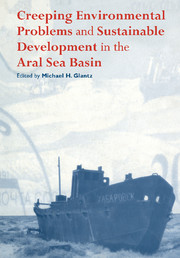Book contents
- Frontmatter
- Contents
- List of contributors
- Introduction
- 1 Sustainable development and creeping environmental problems in the Aral Sea region
- 2 Ecological disaster linked to landscape composition changes in the Aral Sea basin
- 3 Alteration of water level and salinity of the Aral Sea
- 4 Desertification in the Aral Sea region
- 5 Climate fluctuations and change in the Aral Sea basin within the last 50 years
- 6 Priaralye ecosystems and creeping environmental changes in the Aral Sea
- 7 Public health in the Aral Sea coastal region and the dynamics of changes in the ecological situation
- 8 The impact of political ideology on creeping environmental changes in the Aral Sea basin
- 9 Change of the rivers' flow in the Aral Sea basin (in connection with the problem of quantitative assessment and consideration of environmental after-effects)
- 10 Fish population as an ecosystem component and economic object in the Aral Sea basin
- 11 Creeping environmental changes in the Karakum Canal's zone of impact
- 12 Environmental changes in the Uzbek part of the Aral Sea basin
- 13 Creeping changes in biological communities in the Aral Sea
- Index
7 - Public health in the Aral Sea coastal region and the dynamics of changes in the ecological situation
Published online by Cambridge University Press: 19 October 2009
- Frontmatter
- Contents
- List of contributors
- Introduction
- 1 Sustainable development and creeping environmental problems in the Aral Sea region
- 2 Ecological disaster linked to landscape composition changes in the Aral Sea basin
- 3 Alteration of water level and salinity of the Aral Sea
- 4 Desertification in the Aral Sea region
- 5 Climate fluctuations and change in the Aral Sea basin within the last 50 years
- 6 Priaralye ecosystems and creeping environmental changes in the Aral Sea
- 7 Public health in the Aral Sea coastal region and the dynamics of changes in the ecological situation
- 8 The impact of political ideology on creeping environmental changes in the Aral Sea basin
- 9 Change of the rivers' flow in the Aral Sea basin (in connection with the problem of quantitative assessment and consideration of environmental after-effects)
- 10 Fish population as an ecosystem component and economic object in the Aral Sea basin
- 11 Creeping environmental changes in the Karakum Canal's zone of impact
- 12 Environmental changes in the Uzbek part of the Aral Sea basin
- 13 Creeping changes in biological communities in the Aral Sea
- Index
Summary
Introduction
The challenging problems of the Aral Sea coastal region, which have arisen following striking changes in ecological conditions in the area, now seem to have been the logical result of the ill-considered planning of anthropogenic impacts on natural resources and human habitat.
A comprehensive analysis of the process of development of current ecological conditions (and its impacts on the way of life and on public health) is of interest from both a scientific and a practical point of view. In this regard the Aral Sea coastal region is an appropriate subject of research, because the pronounced and ecologically important natural processes and phenomena observed here were accompanied by sharp, adverse changes in the region's medical and demographic conditions.
The existence of ‘green’ and ‘brown’ ecological problems (Vogel, 1994), most often the result of creeping environmental changes (i.e., slowly changing, incremental, cumulative processes), is fairly obvious:
Green issues refer to those problems at the top of environmental agendas throughout the world, including ozone, greenhouse, and related global climatic change. Brown environmental issues … include waste removal, safe water provision, urban health problems, inadequate sanitation, and local air pollution.
(Vogel, 1994,p. 233)It is unclear, however, on what time scales the initially unmonitored processes are altered. To what extent and with what degree of degradation (or transformation) of the environment are they connected? Do these processes reach identifiable threshold values? Is it possible to change negative patterns and trends once we begin to speak of crisis? Perhaps we can establish thresholds (i.e., levels) of ecological change by assessing the character and importance of related processes.
- Type
- Chapter
- Information
- Publisher: Cambridge University PressPrint publication year: 1999
- 4
- Cited by



